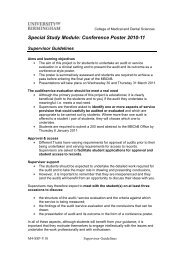Contents - College of Medical and Dental Sciences - University of ...
Contents - College of Medical and Dental Sciences - University of ...
Contents - College of Medical and Dental Sciences - University of ...
You also want an ePaper? Increase the reach of your titles
YUMPU automatically turns print PDFs into web optimized ePapers that Google loves.
The 11 th International Workshop on KSHV & Related Agents, Birmingham, UK<br />
Poster Session Abstract P17<br />
C-MAF: A KSHV MICRORNA TARGET<br />
Amy Hansen 1 , Dimitris Lagos 1 , Stephen Henderson 1 , Vicky Emuss 1 Fiona Gratrix 1 , Rolf<br />
Renne 2 <strong>and</strong> Chris Bosh<strong>of</strong>f 1<br />
1 Cancer Research UK Viral Oncology Group, UCL Cancer Institute, Paul O’Gorman<br />
Building, Huntley Street, <strong>University</strong> <strong>College</strong> London, WC1E 6BT, London, U.K.<br />
Abstract<br />
MicroRNAs are small non-coding RNA molecules which post-transcriptionally regulate<br />
gene expression by either blocking translation or inducing mRNA degradation. KSHV<br />
encodes 12 microRNAs located within the latency-associated region <strong>of</strong> the genome; ten<br />
microRNAs are clustered <strong>and</strong> co-expressed. Despite being identified 3 years ago, few<br />
KSHV microRNA targets have been identified. We present microRNA pr<strong>of</strong>iling data which<br />
confirms the expression <strong>of</strong> viral microRNAs in our in vitro endothelial cell model <strong>of</strong><br />
primary infection <strong>and</strong> in vivo within KS lesions. We sought to identify cellular targets <strong>of</strong><br />
the KSHV microRNA cluster in human lymphatic endothelial cells (LECs). Gene expression<br />
microarray pr<strong>of</strong>iling <strong>of</strong> LECs infected with lentivirus expressing either microRNA cluster or<br />
empty vector identified cellular targets silenced by microRNA induced mRNA degradation.<br />
Several genes were significantly deregulated; amongst these was the transcription factor<br />
c-Maf, an oncogenic avian retrovirus homologue. C-maf overexpression transforms B <strong>and</strong><br />
T cells, however its function in endothelial cells is poorly characterised. In silico<br />
prediction analysis identified several potential KSHV microRNA target sites within the c-<br />
Maf 3’UTR. We have subsequently identified miR-K12-11 <strong>and</strong> miR-K12-6 as the principle<br />
silencers <strong>of</strong> c-Maf. In addition we show that silencing is mediated by direct microRNA<br />
interaction with the c-Maf 3’UTR. This work identifies <strong>and</strong> experimentally validates c-Maf<br />
as the first endothelial-specific KSHV microRNA target.<br />
Presenting author Email: amy.hansen@wibr.ucl.ac.uk<br />
114















